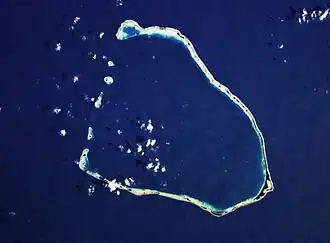Nukumanu language
| Nukumanu | |
|---|---|
 | |
| Native to | Papua New Guinea |
| Region | Nukumanu |
Native speakers | 700 (2003)[1] |
| Language codes | |
| ISO 639-3 | nuq |
| Glottolog | nuku1258 |
Nukumanu is a Polynesian language, spoken by about 700 people on Nukumanu in the eastern islands of Papua New Guinea.[2] It is one of the most endangered languages in the region.[3]
Vocabulary
| English | Nukumanu |
|---|---|
| Coconut palm | níu |
| Breadfruit tree | 'úlu |
| Banana | hŭki |
| Hibiscus | hau |
| Sugar cane | kólo |
| Tree | náku |
| Yams | ŭhi |
| A large red berry with no core | puáta |
| A type of fruit with a hard shell | tóno |
| A type of hardwood shrub | heníe |
| Red (colour) | má |
| Green (colour) | eúli |
| Dark (as in deep water/far away) | upála |
References
- ^ Nukumanu at Ethnologue (18th ed., 2015) (subscription required)
- ^ Marck, Jeff (2000), Topics in Polynesian languages and culture history. Canberra: Pacific Linguistics
- ^ Robert Blust (2013). The Austronesian languages. Asia-Pacific Linguistics, School of Culture, History and Language, College of Asia and the Pacific, The Australian National University. hdl:1885/10191. ISBN 9781922185075.
- ^ Ergebnisse der Südsee-Expedition, 1908-1910. Hamburg: L. Friederichsen. 1914. pp. 31, 51. OCLC 13389966.
Further reading
- Ray, Sidney H. "Polynesian Linguistics. III. Polynesian Languages Of The Solomon Islands". The Journal of the Polynesian Society. 25 (97): 18–23.